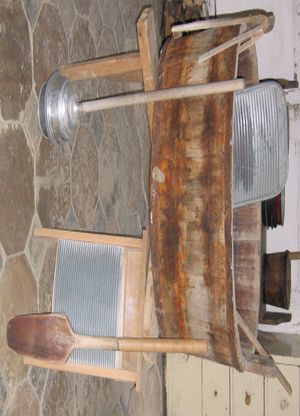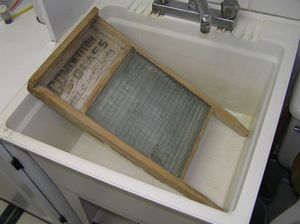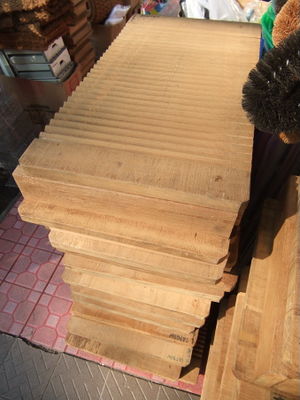Washboard
A washboard is a tool designed for hand washing clothing. With mechanized cleaning of clothing becoming more common by the end of the 20th century, the washboard has become better known for its originally subsidiary use as a musical instrument.
The traditional washboard is usually constructed with a rectangular wooden frame in which are mounted a series of ridges or corrugations for the clothing to be rubbed upon. For 19th century washboards, the ridges were often of wood; by the 20th century, ridges of metal were more common. A "fluted" metal washboard was patented in the US in 1833. Zinc washboards were manufactured in the US from the middle of the 19th century. In the late 20th century and early 21st century, ridges of galvanized steel are most common, but some modern boards are made of glass. Washboards with brass ridges are still made, and some who use washboards as musical instruments prefer the sound of the somewhat more expensive brass boards. One of the few musical instruments invented in America is the Zydeco Frottoir (Zydeco Rubboard), a distillation of the washboard into essential elements (percussive surface with shoulder straps) designed by Clifton Chenier and built by Willie Landry in 1946.
The washboard used for laundry
Though the washboard is generally used today as a musical instrument or sound-making device, many parts of the world still use them for washing clothes. Clothes are soaked in hot soapy water in a washtub or sink, then squeezed and rubbed against the ridged surface of the washboard to force the cleansing fluid through the cloth to carry away dirt. Washboards may also be used for washing in a river, with or without soap. Then the clothes are rinsed. The rubbing has a similar effect to beating the clothes and household linen on rocks, an ancient method, but is less abrasive.
The washboard (insert) made of glass
The original wash boards with the glass insert were made during WW II because all the metal was being sent to the war effort. Reproductions look like the antiques, but are modern made.
The washboard (insert) made of wood (a wood only washboard)
It is possible to make the insert of wood.


